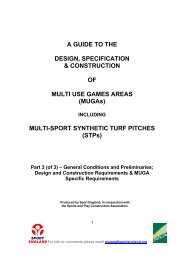View - North East Lincolnshire Council
View - North East Lincolnshire Council
View - North East Lincolnshire Council
You also want an ePaper? Increase the reach of your titles
YUMPU automatically turns print PDFs into web optimized ePapers that Google loves.
BOC Immingham Dissolved Acetylene Project Environmental Statement: Vol. 2 Main Text<br />
Impact Assessment<br />
Construction<br />
7.73 The land contamination impact assessment is based on the change in risk between the baseline<br />
and the construction phase. Construction activities by their very nature (and as described earlier)<br />
slightly increase the likelihood of exposure to contamination introduce potential sources. Good<br />
practice methods will be employed which will include measures to minimise the pathway and or<br />
reduce the source potential for exposure. A CEMP will be prepared and implemented, which will<br />
ensure that appropriate procedures will be in place to minimise risks and provide a means of<br />
monitoring their effectiveness. In addition, a construction waste management plan (WMP) will be<br />
developed and implemented as part of the CEMP. On the basis of the above, the construction<br />
phase contamination risk assessment is summarised as follows:<br />
� on site human receptors: the probability of the PPL is considered ‘low likelihood’ and the<br />
consequence is considered ‘mild’. Construction activities could increase the potential for<br />
exposure to contaminants in soil (if these are present) and vapour ground gas because<br />
construction activities involve the handling of soil and have the potential to encounter<br />
groundwater by excavation dewatering (potential sources). However, good practice methods<br />
are implemented to reduce such exposure and the risk identified as ‘low’;<br />
� offsite human receptors: the probability of the PPL is considered ‘unlikely’ and the<br />
consequence is considered ‘mild’. Construction activities could increase the potential for<br />
exposure to contaminants in windblown, soil-derived dust (if contaminants are present) and<br />
migrating vapour ground gas because construction activities involve the handling of soil<br />
(potential sources) and potentially changing the vapour ground gas regime. However, good<br />
practice methods are implemented to reduce such exposure activities and the risk identified<br />
as ‘very low’;<br />
� controlled waters receptors (groundwater in the Superficial Deposits): the probability of the<br />
PPL is considered ‘low likelihood’ and the consequence is considered ‘mild’. Construction<br />
activities could increase the potential for mobilisation of contaminants, for example, increased<br />
infiltration and leaching, accidental spillage of pollutants, etc. but good practice methods are<br />
implemented to reduce this possibility and the risk identified as ‘low’;<br />
� controlled waters receptors (Humber Estuary): the probability of the PPL is considered ‘low<br />
likelihood’ and the consequence is considered ‘mild’. Construction activities could increase<br />
the potential for mobilisation of contaminants, for example, in surface water runoff, but good<br />
practice methods are implemented to reduce this possibility and the risk identified as ‘low’;<br />
� on site property receptors (crops): this PPL no longer exists as the on site crops will have<br />
been removed;<br />
� offsite property receptor (crops): the probability of the PPL is considered ‘unlikely’ and the<br />
consequence is considered ‘minor’. Construction activities could increase the potential for<br />
mobilisation of contaminants in windblown, soil-derived dust, but good practice methods are<br />
implemented to reduce this possibility and the risk identified as ‘very low’; and<br />
� offsite property receptor (buildings): the probability of the PPL is considered ‘unlikely’ and the<br />
consequence is considered ‘minor’. Construction activities could increase the potential for<br />
mobilisation of vapours ground gas but good practice methods are implemented to reduce<br />
this possibility and the risk identified as ‘very low’.<br />
7.74 Based on the above, the impact assessment is summarised in Table 7.3.<br />
5100935.404 Environmental Statement August 2011 107




